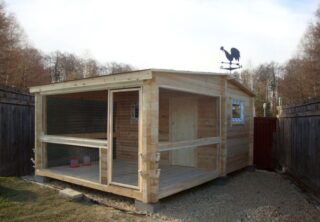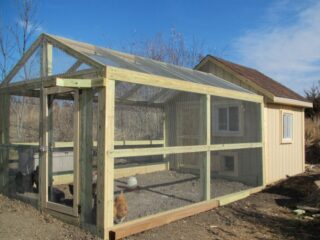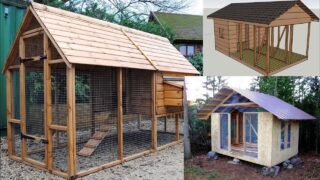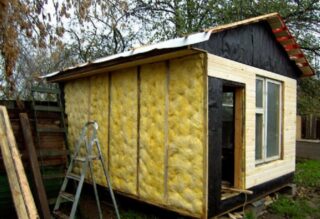An all-season chicken coop for 50 chickens can be built using frame technology and by masonry from bricks or block materials. In this case, special attention should be paid to the insulation of the room.
Site selection and design

First of all, you need to take into account the characteristics of the landscape. In the lowlands, you should not make a poultry house: a lot of water accumulates there and the snow slowly melts, which has a bad effect on the health of the chickens. It is better to locate the premises in an area with a slope to the south: then moisture will be discharged in a timely manner, and the building will be dry and comfortable. There must be enough sun in the building. If the house is rectangular, you can arrange it so that long walls run from east to west. Adequate light will help increase egg production in layers.
Before starting work, you need to draw up a drawing of the building with an indication of the dimensions. You can develop it yourself or use ready-made chicken coops projects for 50 chickens. The diagram shows the placement of window and door openings, perches and nests, components of lighting and heating systems. The places of arrangement of passages for ventilation are also indicated.
As a rule, a winter chicken coop for 50 chickens has an area of at least 10 m². In more compact rooms, the birds will be cramped. You can build a building with wall lengths 4x2.5 m. Its height should be 1.7-2 m.
How to make a chicken coop for 50 chickens with your own hands

To make a do-it-yourself chicken coop for broilers, you can use different types of materials - wood, block products (for example, brick or foam block). A simple and lightweight construction option is an insulated frame, sheathed from the inside with OSB plates. It is easy even for an inexperienced installer to work with this type of cladding.
It is impossible to use profiled sheet and other metal coatings for sheathing: they retain heat very poorly, which cannot but affect the well-being of chickens in winter.
The construction process of such a building is carried out using standard frame technology. A thick layer of mineral wool is well suited as insulation: it not only does an excellent job with its direct function, but also serves as an obstacle for predators who cannot eat this material. If the building is built from blocks, loose expanded clay is also suitable for insulation, which can easily fit into the gaps in the masonry (you should not use it in a wooden poultry house). They will also need to insulate the floor and roof.
To build a do-it-yourself chicken coop for 50 birds, in addition to the building materials themselves, you will need:
- grout components and mixing vessel;
- expanded clay or mineral wool for insulation;
- fasteners - screws and simple nails;
- boards and beams for flooring;
- saw and electric drill;
- Rabitz;
- construction tape and level;
- cord for marking;
- a hammer;
- roofing felt waterproofing;
- roof slate;
- ventilation tube;
- lamps and wiring for lighting.
The foundation can be made of columnar or solid slab. The first option is preferable for a frame building, the second for a brick or block house. The pillars are located at the corners of the building, as well as along its perimeter with a step of 1 m. At the points where they will be mounted, holes are dug and a sand cushion is poured onto the bottom. After pouring, the concrete is left for 2-3 days and then the posts are made out with blocks or bricks.

The finished foundation is covered with waterproofing and then the logs are mounted. They are covered with boards fixed on 2 ordinary nails. Above, waterproofing is again laid and bars with a square section with a side of 10 cm in increments of 0.7-0.8 m are packed. The gaps between them are filled with loose expanded clay. Finishing flooring is organized on top. To protect birds from predators, it is recommended to make hardwood floors (such as oak).
Then the walls are mounted from the selected material. We should not forget about high-quality insulation. For protection from predators, the walls can be plastered with metal mesh.
It is better to make a gable roof: this prevents precipitation from trapping on it, which contributes to a dry and comfortable environment in the chicken coop. The lathing is mounted on the rafters and then the roofing material is attached to it. It is better to make the windows vertical - long and narrow. They are installed on the south side. It is impossible to mount windows and doors on opposite sides, otherwise a draft will be created in the room. Ventilation can be made mechanical (better for a spacious chicken coop) or natural.
It is recommended to place perches away from windows. Their dimensions are selected depending on the size of the hens. If there are 10 birds in the hen house, 2 nests need to be installed in it, if 50 - 10 pieces. The dimensions of a typical nest are 30x40x30 cm. Hay and straw should not be used for them because of their increased tendency to absorb moisture (which creates a risk of contamination with parasites or mold). Feeders and drinkers are placed throughout the area so as to provide access to them for all chickens.
Near the poultry house, you can equip a walking yard with dimensions of 2x2 m, fenced with high-quality metal mesh. A separate door from the building itself should lead into it. A shed is organized over the yard, and perches are mounted on its territory. To protect the hens from predators, the fence net is dug in at least to the depth of the shovel bayonet. Close to it, you need to install stones or bricks around the perimeter.
Conditions for winter keeping birds

For a comfortable life for birds in winter, it is worth taking care of high-quality insulation of the walls, floor and ceiling. Sometimes a building is sheathed on the outside with foam blocks to prevent wind from entering. In addition, you need to insulate the door. On the inside, a woolen curtain is mounted to it.
In the warm season, the hen house has enough natural light, and in winter it is necessary to connect artificial light. Ignoring this will have a bad effect on productivity, since the bird rushes only during the day or in good light. In a room for 50 heads, it is better to install fluorescent lamps or products with LEDs. The latter, although they are more expensive, have a long service life and high-quality lighting of the chicken coop. Incandescent bulbs are a budget option suitable for a small house. They have to be changed frequently.









A warm chicken coop for broilers is absolutely unnecessary, because their maintenance for more than 50 days is unprofitable. After fattening, they are slaughtered and preserved or stored differently.
A warm chicken coop is needed only for layers.